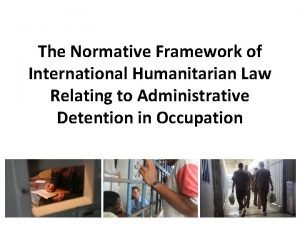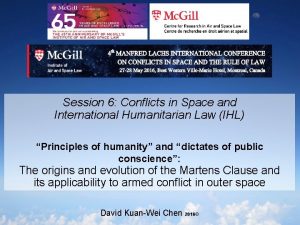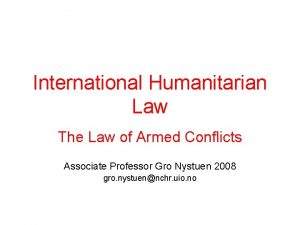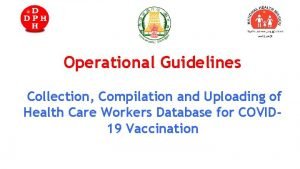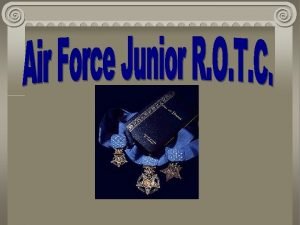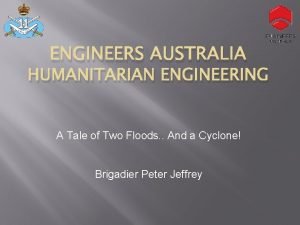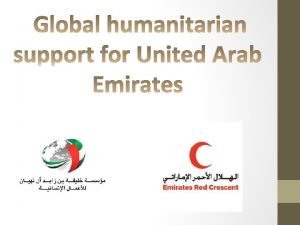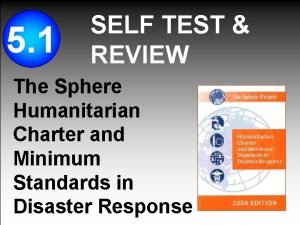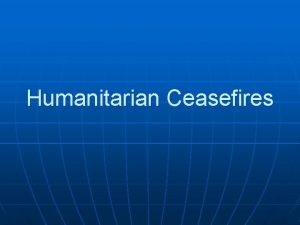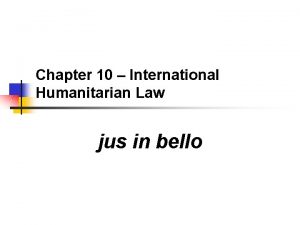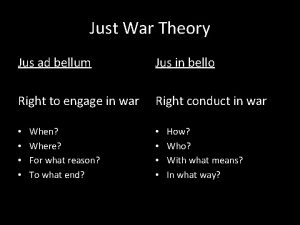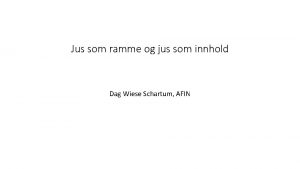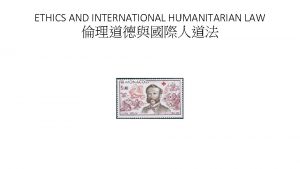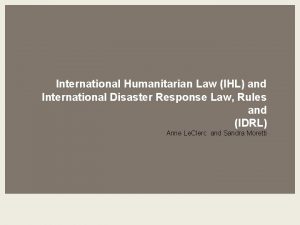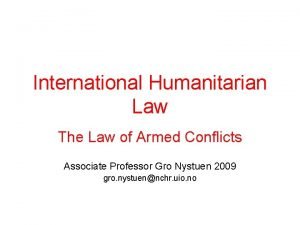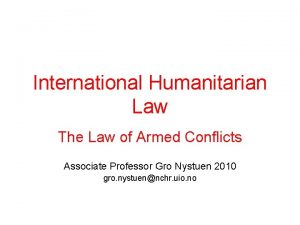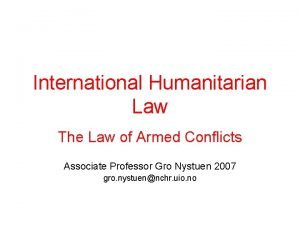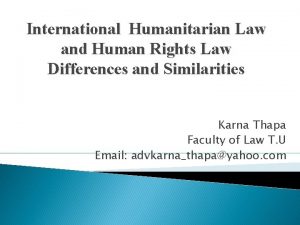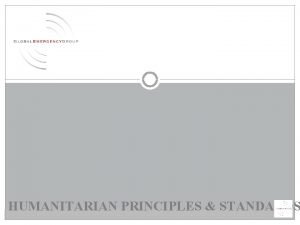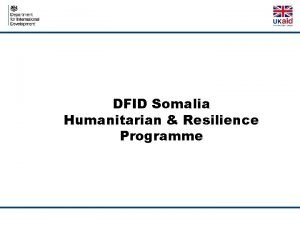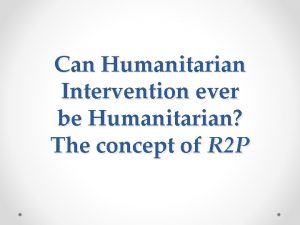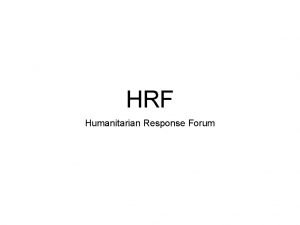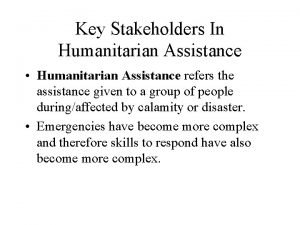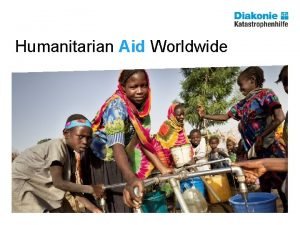JUS 17305730 International Humanitarian Law the Law of







































- Slides: 39

JUS 1730/5730 International Humanitarian Law (the Law of Armed Conflict), autumn 2011 Lecture 1, 29 August 2011: i) Introduction to International Humanitarian Law ii) Qualification of conflicts Kjetil Mujezinović Larsen k. m. larsen@jus. uio. no

Structure of the current lecture 1. Introduction to the course 2. Introduction to international humanitarian law 1. 2. 3. 4. 5. International law Jus ad bellum and jus in bello Brief history of IHL Main sources of IHL Scope of application 3. Qualification of conflicts 1. International armed conflicts and occupation 2. Non-international armed conflicts

INTRODUCTION TO THE COURSE

Practical course information • JUS 5730 International humanitarian law (the law of armed conflict) http: //www. uio. no/studier/emner/jus/JUS 5730/index. xml • Autumn 2011: – – Time and place for teaching and exam Syllabus (achievement requirements) Course outline; style of teaching Student participation?

Useful websites • Treaties: http: //www. icrc. org/ihl • Commentaries: http: //www. icrc. org/ihl. nsf/CONVPRES? Open. View • Other useful links: – ICRC Review: http: //www. icrc. org/eng/review – ICRC databases on IHL: http: //www. icrc. org/eng/resources/ihldatabases/index. jsp – Harvard IHL Research initiative: http: //ihl. ihlresearch. org – Introduction to Public International Law research: http: //www. nyulawglobal. org/Globalex/Public_International_La w_Research 1. htm – Central Human Rights Sources on the Internet: http: //www. jus. uio. no/smr/tjenester/bibliotek/veiledning/humanrights-sources. pdf

INTRODUCTION TO INTERNATIONAL HUMANITARIAN LAW

Terminology and related areas of international law: • International Humanitarian Law (IHL) • Law of Armed Conflict (LOAC) • Jus in bello • International Human Rights Law • International Refugee Law • International Criminal Law

International humanitarian law as a part of international law • Traditionally: International law regulates the relationship between States • States are the core subjects of international law; states have rights and obligations • But individuals can to a certain extent be subjects (dutybearers and rights-holders) under international law – International humanitarian law a good example • International humanitarian law is a part of international law – Sources, methods, implementation, enforcement. . . – But with some special characteristics – Students without previous knowledge of international law are encouraged to familiarise themselves with textbooks on international law, in addition to Kolb’s short introduction

Sources in international law Statute of the ICJ, Art. 38: (a) international conventions, whether general or particular, establishing rules expressly recognized by the contesting states; (b) international custom, as evidence of a general practice accepted as law; (c) the general principles of law recognized by civilized nations; (d) judicial decisions and the teachings of the most highly qualified publicists of the various nations, as subsidiary means for the determination of rules of law.

Method of interpreting treaties Vienna Convention on the Law of Treaties Art. 31. General rule of interpretation. 1. A treaty shall be interpreted in good faith in accordance with the ordinary meaning to be given to the terms of the treaty in their context and in the light of its object and purpose. Art. 32. Supplementary means of interpretation. Recourse may be had to supplementary means of interpretation, including the preparatory work of the treaty and the circumstances of its conclusion, in order to confirm the meaning resulting from the application of article 31, or to determine the meaning when the interpretation according to article 31: (a) leaves the meaning ambiguous or obscure; or (b) leads to a result which is manifestly absurd or unreasonable

Jus ad bellum and jus in bello • Jus ad bellum are the international rules pertaining to to which extent the use of military force against another state is allowed. – Not a key issue in this course

Jus ad bellum The prohibition against use of force: • UN Charter Article 2 (4): The use or threat of use of force against states is prohibited • ICC Statute: Crime of aggression The only exceptions: • UN Security Council resolution (UN Charter Articles 39 – 42) • The right of self defence (UN Charter Article 51) • Humanitarian intervention/responsibility to protect (R 2 P)?

Jus in bello • Jus in bello are the international rules pertaining to how armed conflict must be conducted • Protection of civilians and individuals hors de combat • Protection of combatants • Means and methods of warfare • Relationship to neutral states

No direct link • Violations of jus ad bellum does not justify violations of jus in bello • Violations of jus ad bellum does not entail violations of jus in bello

Brief history of IHL • Many examples of humanitarian rules of warfare throughout history (and many examples of the opposite): Use of poisoned or concealed weapons, killing of prisoners etc. The origins of modern IHL: • The battle of Solferino (1859) – Henri Dunant: “The Memory of Solferino” (1862) • The first Geneva Convention 1864 • The Lieber Code 1863

Core principles of IHL HUMANITY Proportionality Distinction Military necessity

Main Sources of IHL • “Geneva law” Conventions • “Hague law” • International customary law

Geneva Law (primarily pertaining to protection) • The four Geneva Conventions (1949): 1. Wounded and sick soldiers on land 2. Wounded and sick soldiers on sea 3. Prisoners of war 4. Protection of civilians and occupation • The two Additional Protocols (1977): Additional rules on means and protection 1. In international armed conflicts 2. In non-international armed conflicts

Hague Law (primarily pertaining to means of war) • • • The St. Petersburg Declaration 1868 Hague Regulations of 1899 and 1907 Gas protocol of 1925 NPT (non-proliferation of nuclear weapons) 1968 Biological weapons 1972 Convention on inhuman weapons (CCW) 1980 Chemical weapons 1993 Anti Personnel Mines 1997 Cluster Munitions 2008

International Customary Law • ICJ Statutes, Article 38(1). b: “. . international custom, as evidence of a general practice accepted as law; ” – Usus and opinio juris • The ICRC Study on international humanitarian law was commissioned by State Parties to the Geneva Conventions in 1995 • Three volumes in 2005: – 1) The rules (161 rules) – 2 and 3) State practice

Scope of application • PERSONAL scope of application (to which subjects does IHL apply? ) • MATERIAL and TEMPORAL scope of application (in which situations does IHL apply? ) – Material: To which situations? – Temporal: When does the applicability start and end?

Personal scope of application: • To which subjects do IHL apply? – Who is bound by IHL? – Who is protected by IHL? • States (parties to the conflict and to IHL instruments) • Non-state armed groups (parties to the conflict) • Individuals (belonging to parties to the conflict): – Civilians and other protected persons (soldiers hors de combat) (have rights and obligations) – Combatants (have rights and obligations) » Distinction between combatants and non-combatants to be discussed later • International organisations

Material scope of application 1) International armed conflict and occupation 2) Non-international armed conflicts: 2. 1) Wars of national liberation 2. 2) Civil war 2. 3) Other non-international armed conflicts 3) Internal disturbances not amounting to armed conflict 4) Peace

Temporal scope of application • When does the applicability of IHL begin? – The moment of the first hostile act that puts at stake a provision in IHL • When does the applicability of IHL end? – The end of military operations • But when is this?

QUALIFICATION OF CONFLICTS

International conflicts and occupation • IHL applies in international armed conflict or during occupation • What is an international armed conflict? – When the armed forces of one state uses armed force against another state • What is occupation? – When the armed forces of one state occupies territory outside its own territory – Hague Convention IV, annex, art. 42: “Territory is considered occupied when it is actually placed under the authority of the hostile army. ”

Common Article 2, GC • In addition to the provisions which shall be implemented in peacetime, the present Convention shall apply to all cases of declared war or of any other armed conflict which may arise between two or more of the High Contracting Parties, even if the state of war is not recognized by one of them. The Convention shall also apply to all cases of partial or total occupation of the territory of a High Contracting Party, even if the said occupation meets with no armed resistance.

Non-international armed conflict • IHL applies, to a certain extent, in noninternational armed conflicts – When there is a situation in a state that amounts to an armed conflict, IHL applies • What is a non-international armed conflict?

NIAC # 1: Wars of national liberation • Additional Protocol 1 to the Geneva Conventions makes IHL applicable to certain non-international armed conflicts • Article 1(3) and (4): (3) This Protocol, which supplements the Geneva Conventions of 12 August 1949 for the protection of war victims, shall apply in the situations referred to in Article 2 common to those Conventions. (4) The situations referred to in the preceding paragraph include armed conflicts in which peoples are fighting against colonial domination and alien occupation and against racist régimes in the exercise of their right of self-determination, as enshrined in the Charter of the United Nations and the Declaration on Principles of International Law concerning Friendly Relations and Co-operation among States in accordance with the Charter of the United Nations.

NIAC # 2: Civil war • Civil war is an armed conflict between the state authorities of a state and an organised armed group with control over parts of the state territory • Additional Protocol II applies

Article 1, AP II • 1. This Protocol, which develops and supplements Article 3 common to the Geneva Conventions of 12 August 1949 without modifying its existing conditions of application, shall apply to all armed conflicts … which take place in the territory of a High Contracting Party between its armed forces and dissident armed forces or other organized armed groups which, under responsible command, exercise such control over a part of its territory as to enable them to carry out sustained and concerted military operations and to implement this Protocol.

NIAC # 3: Other non-international armed conflicts • Non-international armed conflicts which do not reach the threshold of: – AP I, Article 1 (4): peoples fighting colonial domination etc. – AP II, Article 1: civil war between state military forces and organised armed forces in the territory of the state

Common Article 3, GC: • In the case of armed conflict not of an international character occurring in the territory of one of the High Contracting Parties, each Party to the conflict shall be bound to apply, as a minimum, the following provisions:

The Martens Clause • “Until a more complete code of the laws of war has been issued, the High Contracting Parties. . declare that, in cases not included in the Regulations adopted by them, the inhabitants … remain under the protection and the rule of the principles of the law of nations, as they result from the usages established among civilized peoples, from the laws of humanity, and the dictates of the public conscience”. • Hague Convention IV: “Convention (IV) respecting the Laws and Customs of War on Land its annex: Regulations concerning the Laws and Customs of War on Land”. The Hague, 18 October 1907.

Internal disturbances • IHL does not apply. • Article 1, AP II: • 2. This Protocol shall not apply to situations of internal disturbances and tensions, such as riots, isolated and sporadic acts of violence and other acts of a similar nature, as not being armed conflicts. • What is the threshold?

Peace • IHL does not apply • With certain exceptions regarding the use of the Red Cross/Red Crescent emblem, placement of military buildings etc.

De facto situations Applicable IHL: 1. INTERNATIONAL ARMED CONFLICT PLUS OCCUPATION GC Common Art. 2 AP I, Art. 1 2. NON-INTERNATIONAL ARMED CONFLICT: 2. 1 Wars of national liberation GC Common Art. 2 AP I, Art. 1 2. 2. Non-international armed conflict (Civil war) between the state and organized group with territorial control AP II Art. 1 2. 3. Other non-international armed conflict between the state and groups or between groups GC Common Art. 3 3. Disturbances Riots/Unrest Disasters Others causes for state of emergency Not IHL 4. Peace Not IHL

Qualification of situations • Never assume that any substantive IHL rule applies before having made the determination of what kind of situation you are dealing with. • If in doubt about how to categorise the situation, always assume that the regime giving the most protection is applicable (and explain why you do this).

Contact information: Kjetil Mujezinović Larsen Associate Professor, the Norwegian Centre for Human Rights Phone: +47 22 84 20 83 E-mail: k. m. larsen@nchr. uio. no
 International humanitarian law icrc
International humanitarian law icrc International humanitarian law icrc
International humanitarian law icrc Ihl
Ihl Ee.humanitarian response.info/x/vpdlixjf
Ee.humanitarian response.info/x/vpdlixjf Humanitarian work psychology
Humanitarian work psychology Humanitarian projects in prague for youth
Humanitarian projects in prague for youth Humanitarian
Humanitarian Humanitarian programme cycle 2021
Humanitarian programme cycle 2021 Longevity ribbon jrotc
Longevity ribbon jrotc Afjrotc aef badge
Afjrotc aef badge Humanitarian engineers in cape york
Humanitarian engineers in cape york Khalifa humanitarian foundation
Khalifa humanitarian foundation Sphere book humanitarian
Sphere book humanitarian Humanitarian work psychology
Humanitarian work psychology Hình ảnh bộ gõ cơ thể búng tay
Hình ảnh bộ gõ cơ thể búng tay Slidetodoc
Slidetodoc Bổ thể
Bổ thể Tỉ lệ cơ thể trẻ em
Tỉ lệ cơ thể trẻ em Chó sói
Chó sói Chụp phim tư thế worms-breton
Chụp phim tư thế worms-breton Chúa yêu trần thế
Chúa yêu trần thế Các môn thể thao bắt đầu bằng tiếng đua
Các môn thể thao bắt đầu bằng tiếng đua Thế nào là hệ số cao nhất
Thế nào là hệ số cao nhất Các châu lục và đại dương trên thế giới
Các châu lục và đại dương trên thế giới Cong thức tính động năng
Cong thức tính động năng Trời xanh đây là của chúng ta thể thơ
Trời xanh đây là của chúng ta thể thơ Mật thư tọa độ 5x5
Mật thư tọa độ 5x5 Làm thế nào để 102-1=99
Làm thế nào để 102-1=99 độ dài liên kết
độ dài liên kết Các châu lục và đại dương trên thế giới
Các châu lục và đại dương trên thế giới Thơ thất ngôn tứ tuyệt đường luật
Thơ thất ngôn tứ tuyệt đường luật Quá trình desamine hóa có thể tạo ra
Quá trình desamine hóa có thể tạo ra Một số thể thơ truyền thống
Một số thể thơ truyền thống Cái miệng nó xinh thế
Cái miệng nó xinh thế Vẽ hình chiếu vuông góc của vật thể sau
Vẽ hình chiếu vuông góc của vật thể sau Biện pháp chống mỏi cơ
Biện pháp chống mỏi cơ đặc điểm cơ thể của người tối cổ
đặc điểm cơ thể của người tối cổ Thế nào là giọng cùng tên?
Thế nào là giọng cùng tên? Vẽ hình chiếu đứng bằng cạnh của vật thể
Vẽ hình chiếu đứng bằng cạnh của vật thể Phối cảnh
Phối cảnh
